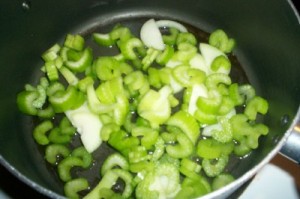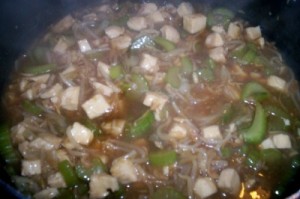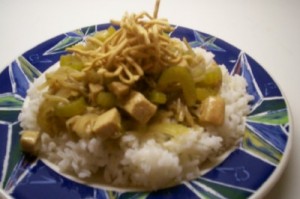Chicken Chow Mein. This is one of those recipes that is so not what it is pretending to be. 1960 was a time when cooking with any Asian influence was new on the scene, and the homemade version of chow mein was about as close as a 1960’s housewife could get to saying “Look dear, I made Chinese today.” I can very easily see this woman talking with her girlfriends over cocktails and bragging about how she made something so exotic.
What made me choose this recipe first was the mere fact that it contained bean sprouts. Not too long ago, we discovered that Zander has a strange fondness for canned bean sprouts. I had bought a can not that long ago to add to a stir fry, only because he had seen the can on the shelf and wondered what they were. So I brought them home, added them to the stir fry, and he proceeded to inhale it, telling me how much he loves bean sprouts. When I saw this recipe for Chicken Chow Mein and saw canned bean sprouts in the ingredient list, as well as celery- two of his favorites, I thought this would be a great place to begin the challenge.
As I read through the recipe, I also had to get in my mind a list of little rules that I was going to use for this challenge. How close would I adhere to the letter of the recipe? When will I be permitted to deviate? I decided that as much as possible, I was going to stick to the recipes exactly as written. Certain changes will be permitted, but only in the case of subbing for like ingredients. For example, this recipe calls for two bouillon cubes. I don’t keep bouillon cubes on hand, but I do keep the granulated soup bases on hand. I subbed in two teaspoons of chicken soup base instead of the bouillon cubes- like product for like product. When it came to the bean sprouts in this recipe, it called for a 19 ounce can. At the store I found 14 ounce and 28 ounce. I bought the larger can, and then left some out of the dish. So for the most part, I will follow the recipes exactly as written in this book.
This was really easy to put together, as I suspect most of the recipes in this book will be. I started by slicing up my one onion, and then slicing up enough celery to get two cups. Right there I noticed something that normally I would have adjusted. My onion was on the small side, so I had this little pile of slices, where I had to slice up three large stalks of celery to get two cups of celery. It seemed to me there should have been more onion- like it should have been measured in cups as well. But I proceeded as directed, and here I have my pile of celery and onion.
This was directed to cook in 2 tablespoons of fat for 10 minutes. I used olive oil for my fat in the pan. What I wondered was what I was looking for in that 10 minutes of time. Was I looking for light browning? Translucency? Softness? The recipe doesn’t say, it just says ten minutes, so I guestimated my ten minutes was up when my celery was beginning to look tender. Then I added my cooked chicken, hot water and chicken soup base. Oh, and the bean sprouts. I brought the whole thing to a boil and then reduced my heat to a simmer.
About this time, I was thinking about how I would serve this Chow Mein. The recipe suggests serving it over Chow Mein noodles. You know, those crunchy sticks on the bottom shelf of the Asian aisle at the store. That just didn’t quite sound right to me. So I decided we would have the Chow Mein noodles sprinkled over the top, and we would serve the Chow Mein over rice. So I got a pot of plain old white rice cooking up while I finished off the Chow Mein.
After a little simmering, I added the 2 tablespoons of soy sauce, black pepper, and then my slurry of cornstarch and water. Once the mixture was thickened and bubbly, it was ready to be eaten. I have to admit right here that the pot didn’t smell all that great. I wasn’t thrilled by the aroma it was giving off, so I was a little hesitant to taste it. I also knew that if I was going to adhere to this challenge properly, I needed to avoid the temptation to add anything to this dish. I already resisted the temptation to at least add some carrot for color. I was not going to permit myself to doctor it up by grabbing the Black Bean Sauce from the fridge, or the Oyster Sauce or Hoisin. Bravely, I grabbed a fork and went in for a little taste.
Growing up as a child of the eighties in a rather largish family of five children, sometimes convenience food was a wonderful asset to my mother. One of those convenience foods that made a regular appearance was Chop Suey- made from La Choy brand canned vegetables and whatever leftover meat mom happened to have. It was a great way to stretch a bit of leftover pork roast that wouldn’t have fed two people, let alone a family of seven. While it may not have been a spectacular meal, it was quick, easy, and we all enjoyed Chop Suey night.
This, my friends, tasted EXACTLY like that meal from the can. I kid you not, it was like I was instantly transported to my mother’s dining room table and that Chop Suey meal. The celery, bean sprouts and onions got a touch soft, the chicken started to break apart just a little, and the soy sauce and chicken broth mixture totally recreated that inexpensive meal from the can. When I think about how little this meal cost me last night, it makes me think that the next time I’m out I need to see just how much those canned veggies cost, because this may have been the cheaper way to go. Onions, celery, leftover cooked chicken, chicken soup base and soy sauce combined with a bit of cornstarch to thicken, that has to be one affordable meal.
But will I make this exact thing again? No. I want more veggies. At the very least, some sliced carrots and maybe some baby corn. I also would like a little more depth to the sauce, so I would at least add a tablespoon of black bean sauce. But overall, it wasn’t bad, it just wasn’t great or memorable. In one of those instances where you’re getting down to the bare bones in the kitchen and it’s a few days yet until payday, this wouldn’t be a bad choice. I think my decision to serve it over rice was the better way to go because it added some bulk to the meal and filled the tummy more efficiently. However, after I had my portion served over rice, I had to try a small bit served over the chow mein noodles, and I have to confess, I thought it tasted better that way. I still wouldn’t serve it over those crunchy noodles, but I would make sure that when I sprinkled them on top, that it was a hefty sprinkling.
Overall, not bad for a first trip through The Women’s Day Collector’s Cookbook. It may have been unwise for me to begin with the chicken chapter, because now I only have one more opportunity to fall back on a fairly safe category.
As I type these recipes in each time, I’m going to put them in exactly as written in my book – including the quirky little introductions to each recipe. It’s very interesting to see just how recipe writing has evolved over the years so that it makes much more sense.
Chicken Chow Mein
“It’s seasoned with soy sauce.”
1 onion, sliced 2 cups sliced celery 2 tablespoons fat 1 can (19 ounces) bean sprouts, undrained (whoops! I drained!) 1 1/2 cups finely diced cooked chicken 2 chicken bouillon cubes 1 1/2 cups hot water 2 tablespoons soy sauce 2 tablespoons cornstarch 1/4 cup cold water Salt and pepper Chow-mein noodlesCook onion and celery in fat 10 minutes. Add sprouts, chicken, bouillon dissolved in hot water. Bring to a boil; simmer 5 minutes. Add soy sauce. Stir in cornstarch blended with cold water. Cook, stirring until thickened. Season. Serve over noodles, with more soy sauce, if desired. Makes 4 servings.



I tried this recipe and was surprise it tastes really well. Just like what you would buy from a typical Chinese restaurant.
Very descriptive article, I loved that bit. Will there bbe a part 2?